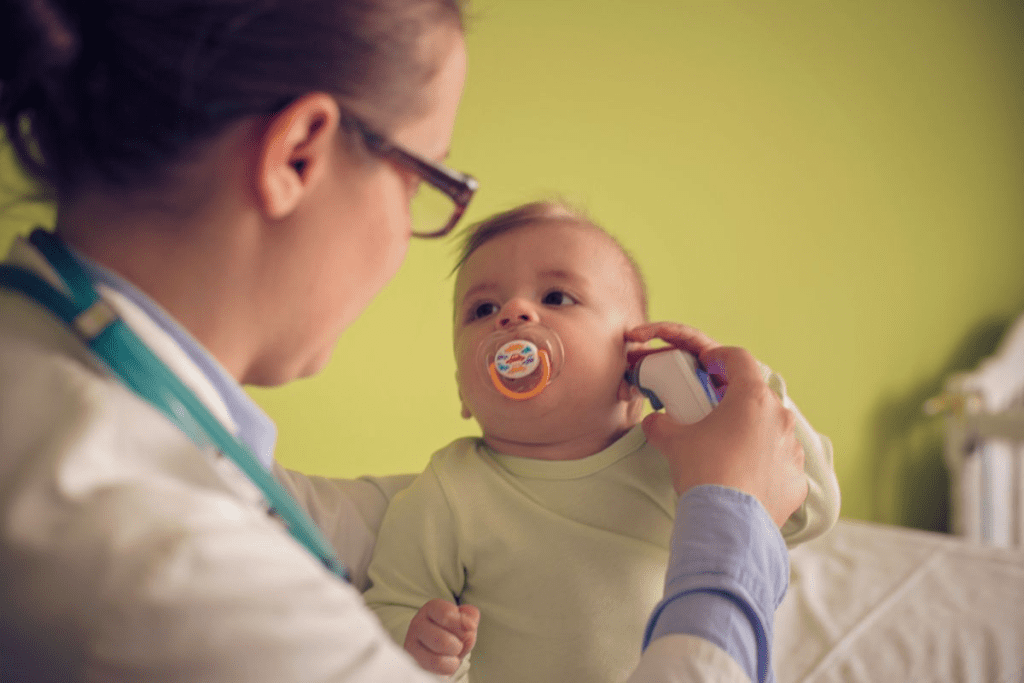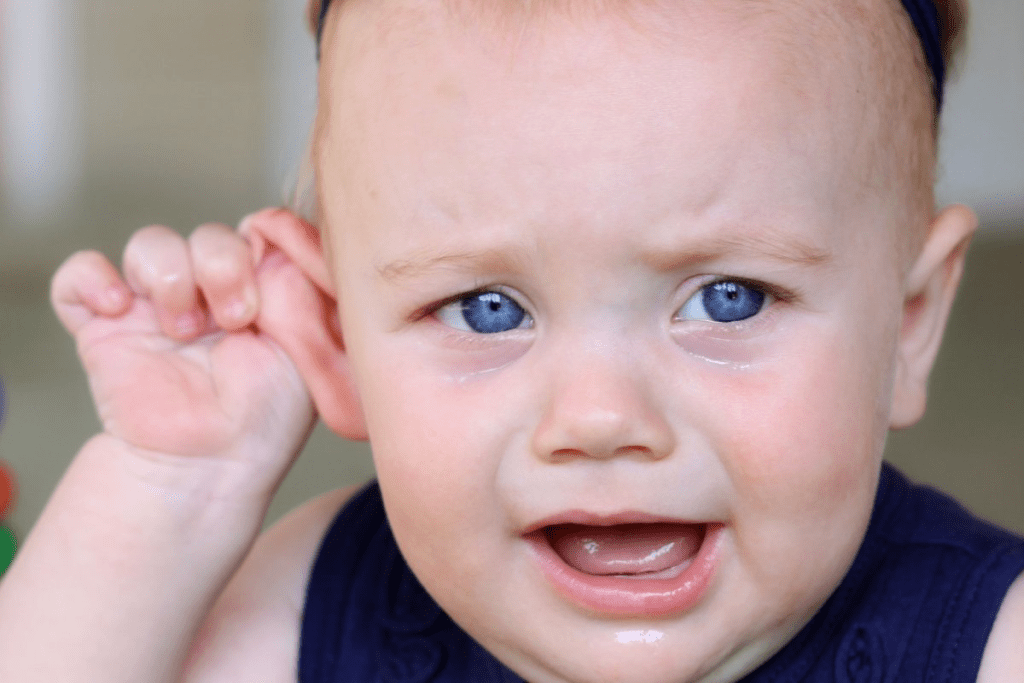Last Updated on November 14, 2025 by

Pediatric ear infections worry many parents. The National Institutes of Health says most kids get at least one ear infection before they’re three. So, the big question is: do ear infections go away on their own, and what causes ear infections in the first place?
Studies show many ear infections clear up without doctor visits. Up to 80% of kids get better in three days, and over 90% without antibiotics. A medical scholar from Johns Hopkins University says, “Many parents worry ear infections will hurt their child’s hearing forever. Or that they won’t notice and treat them.”
We’ll look at the facts and what experts say. This will help parents feel better while also knowing when to seek medical help.
It’s important to know about pediatric ear infections to care for them well. These infections happen when bacteria get trapped in the middle ear. This area is between the ear and the back of the nose and throat.

Otitis media is the most common ear infection in kids. It happens when fluid builds up behind the eardrum. This makes parts of the middle ear get infected and swollen.
There are different kinds of otitis media. These include:
It’s key to spot the signs of ear infection in a baby early. Look for signs like being fussy, having a fever, and trouble sleeping. For more info, check out the National Institute on Deafness and Other Communication website.
Ear infections in young kids come from their ear’s shape and how they live. The Eustachian tube helps control ear pressure. In kids, this tube is shorter and more horizontal, making it easier for bacteria to get in.
Babies and toddlers get ear infections more often because their immune systems are not fully grown. They also catch more viruses. Knowing this helps parents and caregivers spot ear infection symptoms early.
Ear infections in kids worry parents a lot. Knowing why they happen is key to helping them. We’ll look at why kids get ear infections, like from bacteria, viruses, and their body shape.
Ear infections can come from bacteria or viruses. Bacterial infections are often worse and need antibiotics. The usual culprits are Streptococcus pneumoniae and Haemophilus influenzae.
Viral infections are more common and often get better by themselves. Viruses like RSV and flu can also cause ear infections.
Knowing if an ear infection is from bacteria or a virus is important. It helps decide how to treat it.
Kids are more likely to get ear infections because of their body shape. The Eustachian tube is shorter and more horizontal in kids. This makes it hard for fluid to leave the ear, raising the risk of infection.
Also, kids’ immune systems are not fully grown. This makes them less able to fight off infections. We’ll see how these body features increase the risk of ear infections and how to handle them.
By knowing why ear infections happen, parents and caregivers can prevent and manage them in kids.
We look at how long ear infections last in kids. Ear infections, or otitis media, are common in children. Knowing how they progress helps parents and caregivers.
Ear infections fall into two main types: Acute Otitis Media (AOM) and Otitis Media with Effusion (OME). Each type has its own timeline for getting better. Knowing these timelines helps us understand what to expect.
AOM starts suddenly with ear pain, fever, and irritability. Luckily, AOM often gets better in a few days. Studies show kids with AOM start feeling better in 2 to 3 days, even without antibiotics.
Pediatric guidelines say most kids with AOM get better in 3 days without antibiotics.

OME is different because fluid stays in the middle ear after an infection. It can last longer than AOM and may not have sudden symptoms.
The time it takes for OME to resolve varies a lot. Some kids clear the fluid in weeks, while others take months.
Knowing the difference between AOM and OME helps parents and caregivers. It guides them through the recovery and when to see a doctor again.
Experts now suggest a “wait-and-see” approach for some ear infections in kids. This means watching the child closely and using over-the-counter pain relievers as needed. This strategy is called “watchful waiting.”
David Tunkel, M.D., says, “If your child isn’t in severe pain, your doctor might suggest waiting and using over-the-counter pain relievers. This is because many ear infections are caused by viruses, and antibiotics don’t work against them.”
Many studies show that a lot of ear infections get better on their own without antibiotics. A key study found that nearly 80% of children with acute otitis media (AOM) got better without antibiotics. This supports the “watchful waiting” approach as a safe and effective first step.
The benefits of “watchful waiting” include:
“Watchful waiting” is best when the child’s symptoms are mild. Signs for watchful waiting include mild ear pain, low-grade fever, and no severe symptoms like high fever or intense pain. It’s important for parents to work with their healthcare provider to decide the best action.
The decision to use “watchful waiting” depends on:
Understanding when “watchful waiting” is right and getting support from healthcare professionals helps parents make good choices. This approach not only manages the current infection but also helps use antibiotics wisely.
It’s important to know the signs of ear infections in young kids. This is because they can’t tell us how they feel. Ear infections can be hard to spot in babies and toddlers.
Infants with ear infections show certain signs. These include:
Toddlers and older children show different signs of ear infections. These include:
Knowing when to seek medical help is key. If your child has:
Seek a healthcare professional if unsure about your child’s symptoms or if they don’t go away.
Many parents worry about ear infections in their kids. Knowing the risk factors helps prevent and manage them. Young children, from birth to four years, are more likely to get ear infections.
Young kids get ear infections more often because of their body shape. Their eustachian tubes are shorter and more horizontal. This makes it easier for bacteria to get into the middle ear. As kids grow, their eustachian tubes get longer and more vertical, lowering the risk of infection.
Secondhand smoke is a big risk for ear infections in kids. It can irritate the eustachian tube and make infections more likely. Keeping the environment smoke-free is key to lowering this risk.
Kids in daycare are more likely to get ear infections. They’re exposed to more viruses and bacteria. Being around sick kids increases the chance of getting sick too.
Some kids are more likely to get ear infections because of their body shape or size. For example, bigger adenoids can block the eustachian tube. Genetics also play a part, with some families more prone to ear infections.
Key Risk Factors:
Knowing these risk factors helps parents and caregivers prevent ear infections in kids. By understanding these factors, we can take steps to lower the risk of ear infections.
Ear infections can be very painful and uncomfortable. But, there are home strategies that can help. When an ear infection goes away by itself, taking care at home is key. It helps ease symptoms and supports recovery.
For pain and fever, give your child acetaminophen or ibuprofen as needed. Always follow the dosage instructions to avoid side effects. Your doctor might also suggest pain-relieving ear drops, but only if the eardrum is not broken.
Using a warm compress on the ear can also help. Soak a washcloth in warm water, wring it out, and apply it to the ear for a few minutes. This can lessen pain and discomfort.
Keep an eye on your child’s symptoms and health during recovery. Make sure they get enough rest and stay hydrated. Elevating their head while sleeping can also help reduce congestion.
Keeping the environment clean is important. Regularly clean surfaces and toys to prevent infection spread. Also, avoid smoke and other irritants to help them heal.
To lower the chance of ear infections coming back, practice good hygiene. Wash hands often, and avoid secondhand smoke. Keeping vaccinations up to date is also key.
Breastfeeding can protect infants from ear infections. For older kids, teach them to blow their nose correctly. Also, avoid daycare during peak cold and flu seasons.
Knowing if a child’s ear infection will get better on its own is key for parents. We’ve looked into ear infections in kids, including what causes them, their symptoms, and how to treat them. Some ear infections might get better by themselves, but others need medical help to avoid serious problems.
It’s important to know the signs of an infection in a child. This helps decide if we should wait and see or get medical help right away. Working with doctors helps us make the best choice for our child’s health.
We do our best to help our child feel better. We work with their doctor to figure out the best way to handle ear infections. This way, we can help our child get better and stay healthy.
Yes, many ear infections in children can get better without antibiotics. But, it’s important to watch for symptoms and see a doctor if they get worse or don’t go away.
Signs include fever, being irritable, and pulling at the ear. They also might have trouble sleeping and eating less. Older kids might feel ear pain and have trouble hearing.
Ear infections can last different lengths of time. Acute otitis media usually gets better in a few days to a week. Otitis media with effusion can last weeks or months.
Watchful waiting means watching the child’s symptoms without antibiotics right away. It’s often suggested for mild cases of acute otitis media in older kids.
Not all ear infections can be prevented, but some steps can help. Avoiding smoke, getting flu and pneumococcus vaccines, and good hygiene are important.
Risk factors include being under 3, daycare, smoke exposure, and certain health conditions. Knowing these can help prevent and manage ear infections.
At home, you can use pain meds like acetaminophen or ibuprofen. Warm compresses on the ear and plenty of rest also help.
See a doctor for severe ear pain, fever over 102 °F, ear discharge, hearing loss, or if symptoms get worse or don’t improve.
Yes, recurrent ear infections can cause hearing problems and speech delays. Regular doctor visits can help prevent these issues.
Subscribe to our e-newsletter to stay informed about the latest innovations in the world of health and exclusive offers!